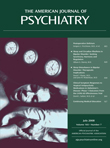In This Issue
Antipsychotics in Alzheimer’s Disease
Psychiatric symptoms were improved more by second-generation antipsychotic drugs than by placebo in 421 outpatients with Alzheimer’s disease who had psychotic symptoms or agitation. For patients who completed 12 weeks of treatment with olanzapine, quetiapine, or risperidone, the proportions who were “much” or “very much” improved were 45%, 52%, and 61%, compared to 40% who were improved with placebo. Sultzer et al. (CME, p. Original article: 844 ) found that treatment effects in the Clinical Antipsychotic Trials of Intervention Effectiveness—Alzheimer’s Disease (CATIE-AD) varied among the antipsychotics and specific symptoms. The effect on hostility—including anger, aggression, and paranoia—was most notable. None of the drugs, however, improved cognition, depression, functional abilities, care needs, or quality of life. Dr. Susan Schultz reviews these CATIE-AD results in an editorial on p. Original article: 787 .

Targeting Geriatric Depression
Two articles on depression seek greater precision in making treatment decisions and understanding brain mechanisms in elderly patients. Andreescu et al. (CME, p. Original article: 855 ) developed decision trees that guide treatment on the basis of clinical factors and age. Their analysis used pooled data from three studies including a total of 472 patients. Treatment response at 12 weeks was related most strongly to early response at 4 weeks, anxiety level, and age. A second model, minimizing false predictions of nonresponse, is based on early response and sleep disturbance. Brain dysfunction in geriatric depression was examined by Wang et al. (p. Original article: 863 ). They administered a cognitive test with both affective and attentional challenges to three elderly groups: depressed, formerly depressed, and healthy. Functional magnetic resonance imaging showed differences among the groups during detection of visual targets but not emotional processing, suggesting that problems in executing mental processes are prominent in this condition. Several brain regions were involved, and some abnormalities were shared by the currently and formerly depressed groups. In his editorial on p. Original article: 790 , Dr. George Alexopoulos relates these findings to the personalization of treatment for geriatric depression.
Computer-Assisted Addiction Treatment
Patients with substance dependence who received computerized cognitive-behavioral therapy (CBT) in addition to the usual treatment had a lower rate of positive urine specimens over 8 weeks (34% compared to 53% for patients receiving standard treatment only). Carroll et al. (p. Original article: 881 ) included patients addicted to various substances, although cocaine was the most common. The 35 people randomly assigned to computerized CBT plus usual treatment were offered six CBT lessons on specific skills. Each module began with a brief movie and ended with a homework assignment. The mean number of modules completed was 4.3. The numbers of completed homework assignments, sessions attended, and days in the program were correlated with negative urine samples and days of abstinence. Dr. John Greist discusses treatment of substance use disorders in an editorial on p. Original article: 793 .
Fear of the Unknown in Panic Disorder
Greater anxiety in anticipation of unpredictable unpleasant events distinguishes patients with panic disorder from healthy subjects. Grillon et al. (p. Original article: 898 ) measured eyelid movements when the subjects were startled by puffs of air on the forehead. They compared this startle response during a neutral period with the response when the subjects were being periodically exposed to unpleasant sounds, some of which were preceded by visual cues. The differences between the neutral and predictable conditions were similar in the panic disorder patients and healthy subjects. In the unpredictable condition, however, the patients showed a greater difference. This vulnerability to unpredictability could be an innate trait or a response to repeated panic attacks. Dr. Walton Roth explores the possibilities for translational research in an editorial on p. Original article: 796 .



